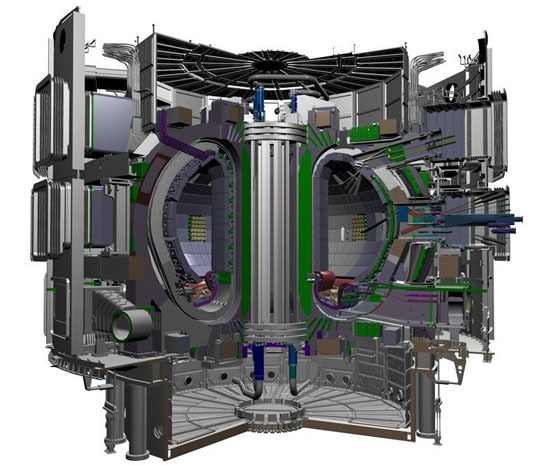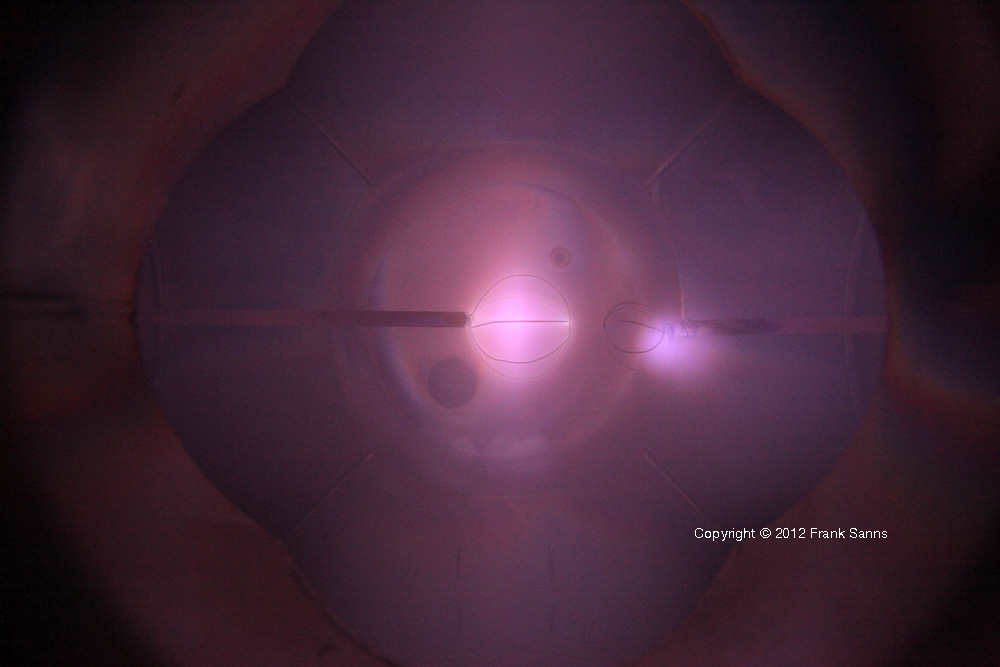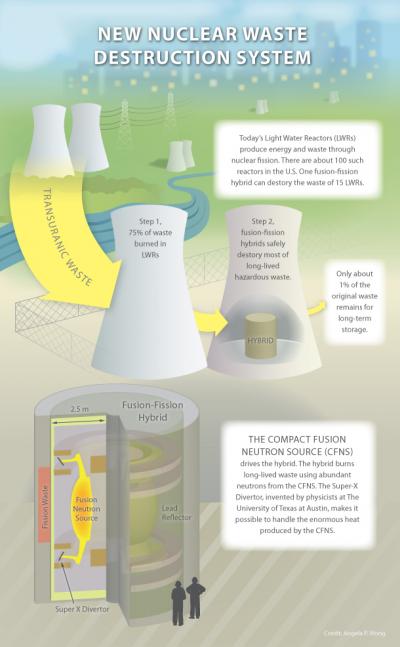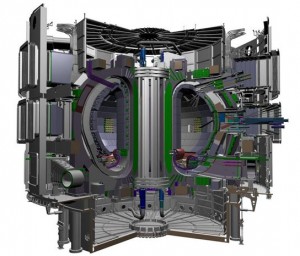
When will we have a commercial fusion reactor? Are we forever to be told sometime in the next 30 years?
It would seem as we tackle the environmental consequences of our dependence on fossil-fuel energy that nuclear would be a suitable alternative. But when we look around the world Japan is wrestling with whether to remain in the nuclear reactor game after the post-tsunami Fukushima-Daiichi meltdown, and Germany is in the process of removing nuclear from its energy mix. So the nuclear energy industry is once again hard pressed to present its solutions as a saleable alternative to other energy generating technologies. But what if we could get fusion reactors going? Now that would make quite a different statement for nuclear power. Why? Because there’s a big difference between fusion and fission reactors.
Fusion vs. Fission
Fission relies on fuels like uranium and plutonium. These are fuels that can be found in nuclear weapons. The future of fission reactor technology is looking to thorium as a fuel that may serve as a restart for this type of energy generation.
Fusion, on the other hand, relies on deuterium and tritium, neither of which are bomb materials. And unlike uranium and plutonium, deuterium is abundant, found in one out of every 6,700 atoms in a cup of seawater, and in that fraction of a cup capable of producing the equivalent energy of 72 liters (19 gallons) of gasoline. That’s enough energy to drive my SUV from Toronto to Montreal and halfway back.
- Fission, on the left, derives energy from splitting atoms, releasing sub-atomic particles and significant energy. Fusion, on the right, squeezes atoms together to generate much more energy than fission. Source: Lawrence Livermore Laboratory
Fission brings sub-critical masses of fuel together to create a super-critical mass which starts a chain reaction that generates energy as a byproduct of the nuclear reaction. In fusion, on the other hand, the fuel gets heated to form a plasma which causes individual atoms to fuse together generating lots of energy as a byproduct.
Fission has been with us since shortly after World War II, a byproduct of building nuclear reactors to drive submarines. Naval engineers took their fission reactor designs and scaled them to create the nuclear power industry of today. Fission reactors have come in several different designs. Deuterium, heavy-water reactors, are Canadian manufactured. Light water reactors are commonly found in the United States. Fast breeder reactors can be found in France. And the Soviet Union has its own reactor designs. Today China is experimenting with thorium nuclear fission reactors. But in all of these different engineered solutions the principles remain the same. The nuclear reaction is used to generate heat and through a heat exchange system to create high-pressure steam to drive turbines connected to generators.
Fission Reactors are Not Fail Safe
We have seen several accidents in the last 40 years. Three-Mile Island, Chernobyl and Fukushima-Daiichi, all have shaken public confidence in fission technology.
Nuclear meltdowns at fission reactors pose enormous environmental problems with surrounding areas exposed to high and low doses of radiation. This happened at Chernobyl and Fukushima-Daiichi. In addition nuclear fission-based reactors create a spent fuel problem. Currently the majority of spent fission fuels get stored on premises at nuclear power plants, posing a continuing security and bio-hazard risk. The industry continues to seek a permanent burial site for what is a highly radioactive unusable byproduct of fission reactors.
Fusion Reactors are Safer
If we develop fusion reactors the inherent problems in current nuclear fission technology would vanish. Fusion energy reactors do not share the same problems associated with fission. The advantages include:
- Fuel is plentiful.
- Fusion reactors cannot experience a meltdown.
- There is no threat of a runaway chain reaction leading to a discharge of radiation.
- There is little in the way of a radiation threat at all.
- Fusion reactors produce no spent fuel.
- When fusion reactors breaks they stop.
- There are few parts to wear out and most of these pose no threat of radiation to operators if maintenance is required.
- Some fusion reactor technologies can recycle and use the radioactive spent fuel from fission reactors as an energy source.
Using abundant raw materials that the Earth will never run out of, a fusion reactor can be the gold standard for nuclear energy generation going forward.
So Where Are We with Fusion?
Garage and Basement Fusors
It seems today that homemade fusion reactors, called fusors, are popping out everywhere. A recent edition of Popular Science magazine featured a story on Taylor Wilson, who at age 14 transformed his family garage in Reno, Nevada, into a nuclear laboratory with a working fusion reactor. He is not alone. According to Fusor.net, an online community of fusioneer hobbyists, there are lots of people building these low-powered fusion devices.
Fusors are based on a design originally created by Philo T. Farnsworth, the inventor of television in the 1920s. Thirty years later Farnsworth came up with the idea of a nuclear fusion reactor which he called Inertial Electrostatic Confinement or IEC. By confining atoms into a small space he created a process that would squeeze atoms so tightly that would fuse together.
The Fusor was born, but the problem with the technology he described was that it didn’t produce a net gain in energy, needing as much energy in to get the energy from the fusion reaction. That made the technology totally impractical for generating power.
Why do Fusors keep popping up in the world of hobbyists? Because two of Farnsworth’s colleagues in 1968 filed a patent for a device that was relatively inexpensive to build and included a vacuum pump, a stainless steel containment vessel, and a power source. Most basement and garage fusors to this day follow the design laid out in this patent. But no Fusor today creates a net energy gain so although fusion takes place it has little potential for solving our energy needs.

Fusion-Fission Hybrid Technology
From garages to major institutions, fusion is being worked on in laboratories and in joint ventures with private industry. One of these projects may even solve the problem of spent fuel from fission reactors.
In 2009 physicists at the University of Texas in Austin developed a concept they labelled a hybrid fusion-fission reactor. Called the Super X Divertor or SXD it included designs for generating neutrons through fusion that would then be fired at spent nuclear fuel from fission reactors. No larger than a small room each SXD would produce pure fusion energy while eliminating the waste fuel output from 10 to 15 light water fission reactors. With light water reactors predominant in the United States (over 100 in operation) this technology could eliminate the spent nuclear fuel problem. As of yet no commercial SXD has been built and it remains a concept only.

A Fusion Reactor Called LIFE
The Lawrence Livermore National Laboratory in California is home to Laser Inertial Fusion Energy, or LIFE. This is a technology at various stages in design and deployment. It uses deuterium and tritium fuel combined with a powerful laser to generate fusion for electrical power.
LIFE would include a target vessel containing a fusion chamber, blanketed by a suitable heat exchange material, an injection and tracking system to monitor the laser and reactor, the laser itself, turbines, generators and transmission lines (see diagram below).

When laser pulses reached the fusion chamber in the reactor temperatures would exceed 100 million degrees Celsius (180 million Fahrenheit). This would fuse the deuterium atoms and release energy in the form of high-energy neutrons (representing about 70% of the total energy generated), x rays, and high-energy ions. Each chamber would contain a meter-thick layer of lithium either in liquid, molten salt or solid form. The lithium would absorb the energy from the fusion reaction and provide a heat source at 600 degrees Celsius (1,112 Fahrenheit). That heat would be used to create super hot steam to drive a turbine connected to a generator. The lithium would produce an additional benefit as it is bombarded by neutrons, creating quantities of tritium to further fuel the reactor, minimizing the need to add fuel to sustain what would be in effect a continuous closed energy producing system.
Like Fusors, LIFE reactors have yet to produce more energy output than the energy going in although this is expected to change in 2012 with a goal to generate energy at 10 to 100 times greater than the energy required to fire the laser.
LIFE is competing with another even bigger project called ITER.
ITER: The Multinational Fusion Reactor Project
ITER is located in France and when completed in 2019 will be ramped up to produce the same type of energy yield as LIFE. Constructed by 6 partner nations and the European Union, ITER is big science.
Like the small science Fusor and the hybrid SXD, ITER creates high energy plasma using a confined magnetic field contained within a vacuum-sealed vessel. The ITER and SXD vessels are called tokamaks. The word tokamak comes from Russian and means a toroidal chamber containing a magnetic field and shaped like a doughnut. And that is exactly what the tokamak looks like (see the central chamber in the cutaway diagram below).

ITER uses deuterium and tritium as fuel. Within the magnetic field temperatures exceed 150 million degrees Celsius (270 million Fahrenheit). That’s hotter by far than temperatures in the Sun’s core. The magnetic field ensures that hot plasma never touches the sides of the chamber.
ITER recently announced a breakthrough developed at the University of Tennessee in Knoxville where engineers took two years to create a new material for the central solenoid, the superconducting coils that confine the plasma. Made from a combination of expoxy and glass fibers and cured at high temperatures, this material will ensure that the heat within the tokamak will not damage the magnetic field generators. It took two years to develop the technology and two days to inject it into the solenoid.
ITER has been more than 25 years in the making with conceptual design work started in 1988. The site is under construction in Aix-en-Provence in Southern France. Assembly of the tokamak is planned to start in 2015 with completion by 2018. The reactor will be fired up for the first time in 2019 and within a few years will be brought up to full power.
Fusion Reactors by 2030
At the beginning of this blog I mentioned 30 years, the usual timeline that “those in the know” make when talking about commercial fusion power generation. With the Super XD Convertor, LIFE and ITER, it appears that we will see fusion reactors well before 2042. In fact it looks very feasible for us to see a variety of technologies rolled out in commercial production by 2030. And who knows, maybe one of those garage and basement Fusors will start emitting excess amounts of energy and change the future of commercial fusion power generation even faster.









